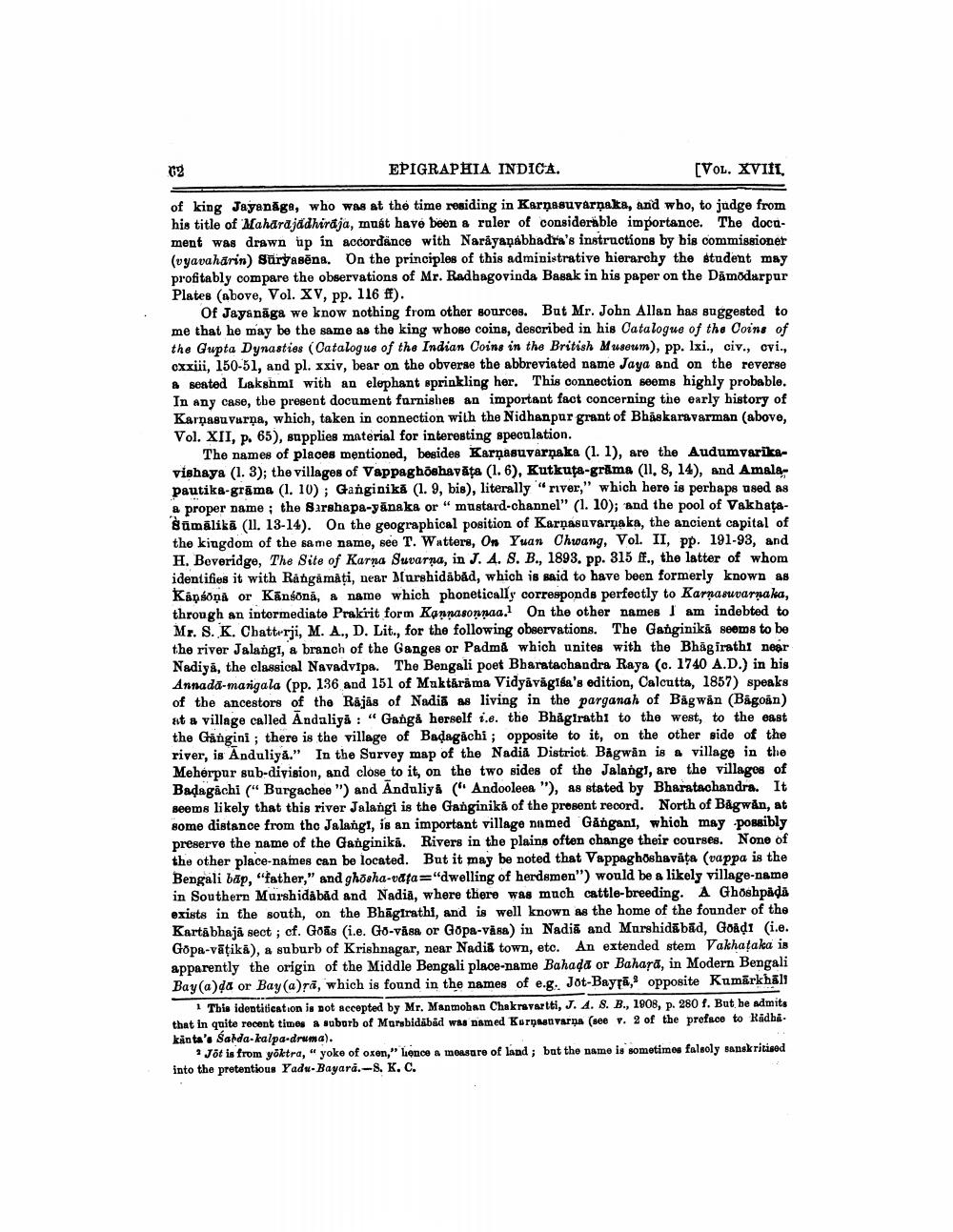________________
02
EPIGRAPHIA INDICA.
[VOL. XVIII.
of king Jayanaga, who was at the time residing in Karnasuvarnaka, and who, to judge from his title of Maharajadhiraja, must have been a ruler of considerable importance. The document was drawn up in accordance with Narayanabhadra's instructions by his commissioner (vyavaharin) Suryasena. On the principles of this administrative hierarchy the student may profitably compare the observations of Mr. Radhagovinda Basak in his paper on the Damodarpur Plates (above, Vol. XV, pp. 116 ).
Of Jayanaga we know nothing from other sources. But Mr. John Allan has suggested to me that he may be the same as the king whose coins, described in his Catalogue of the Coins of the Gupta Dynasties (Catalogue of the Indian Coins in the British Museum), pp. lxi., civ., ovi., exxiii, 150-51, and pl. xxiv, bear on the obverse the abbreviated name Jaya and on the reverse a seated Lakshmi with an elephant sprinkling her. This connection seems highly probable. In any case, the present document furnishes an important fact concerning the early history of Karpasuvarna, which, taken in connection with the Nidhanpur grant of Bhaskaravarman (above, Vol. XII, p. 65), supplies material for interesting speculation.
The names of places mentioned, besides Karnasuvarnaka (1. 1), are the Audumvarikavishaya (1. 3); the villages of Vappaghoshavăța (1. 6), Kutkuta-grama (11, 8, 14), and Amalapautika-grama (1. 10); Ganginika (1. 9, bis), literally "river," which here is perhaps used as a proper name; the Sarshapa-yanaka or "mustard-channel" (1. 10); and the pool of VakhataSumalika (11. 13-14). On the geographical position of Karnasuvarnaka, the ancient capital of the kingdom of the same name, see T. Watters, On Yuan Chwang, Vol. II, pp. 191-93, and H. Beveridge, The Site of Karna Suvarna, in J. A. S. B., 1893. pp. 315 ff., the latter of whom identifies it with Rangamați, near Murshidabad, which is said to have been formerly known as Kapsōna or Känsona, a name which phonetically corresponds perfectly to Karnasuvarnaka, through an intermediate Prakrit form Kannasonnaa. On the other names I am indebted to Mr. S. K. Chatterji, M. A., D. Lit., for the following observations. The Ganginiks seems to be the river Jalangi, a branch of the Ganges or Padma which unites with the Bhagirathi near Nadiya, the classical Navadvipa. The Bengali poet Bharatachandra Raya (c. 1740 A.D.) in his Annada-mangala (pp. 136 and 151 of Muktārama Vidyavägisa's edition, Calcutta, 1857) speaks of the ancestors of the Rajas of Nadia as living in the parganah of Bagwan (Bagoan) at a village called Andaliya: "Gangå herself i.e. the Bhagirathi to the west, to the east the Gangini; there is the village of Badagachi; opposite to it, on the other side of the river, is Anduliya." In the Survey map of the Nadia District. Bagwan is a village in the Meherpur sub-division, and close to it, on the two sides of the Jalang!, are the villages of Badagachi ("Burgachee ") and Anduliya (" Andooleea "), as stated by Bharatachandra. It seems likely that this river Jalangi is the Ganginika of the present record. North of Bagwan, at some distance from the Jalangt, is an important village named Gangani, which may possibly preserve the name of the Ganginika. Rivers in the plains often change their courses. None of the other place-names can be located. But it may be noted that Vappaghoshavata (vappa is the Bengali bap, "father," and ghosha-vata="dwelling of herdsmen") would be a likely village-name in Southern Murshidabad and Nadia, where there was much cattle-breeding. A Ghoshpādā exists in the south, on the Bhagirathi, and is well known as the home of the founder of the Kartabhaja sect; cf. Goas (i.e. Go-vasa or Gopa-vasa) in Nadia and Murshidabad, Goad1 (i.e. Gopa-vātikā), a suburb of Krishnagar, near Nadia town, etc. An extended stem Vakhaṭaka is apparently the origin of the Middle Bengali place-name Bahada or Bahara, in Modern Bengali Bay (a)da or Bay (a)ra, which is found in the names of e.g. Jot-Bayra, opposite Kumarkhäll
1 This identification is not accepted by Mr. Manmohan Chakravartti, J. A. 8. B., 1908, p. 280 f. But he admits that in quite recent times a suburb of Murshidabad was named Karnasuvarna (see v. 2 of the preface to Radhakanta's Sabda-kalpa-druma).
2 Jöt is from yōktra, " yoke of oxen," hence a measure of land; but the name is sometimes falsoly sanskritised into the pretentious Yadu-Bayarā.-S. K. C.




